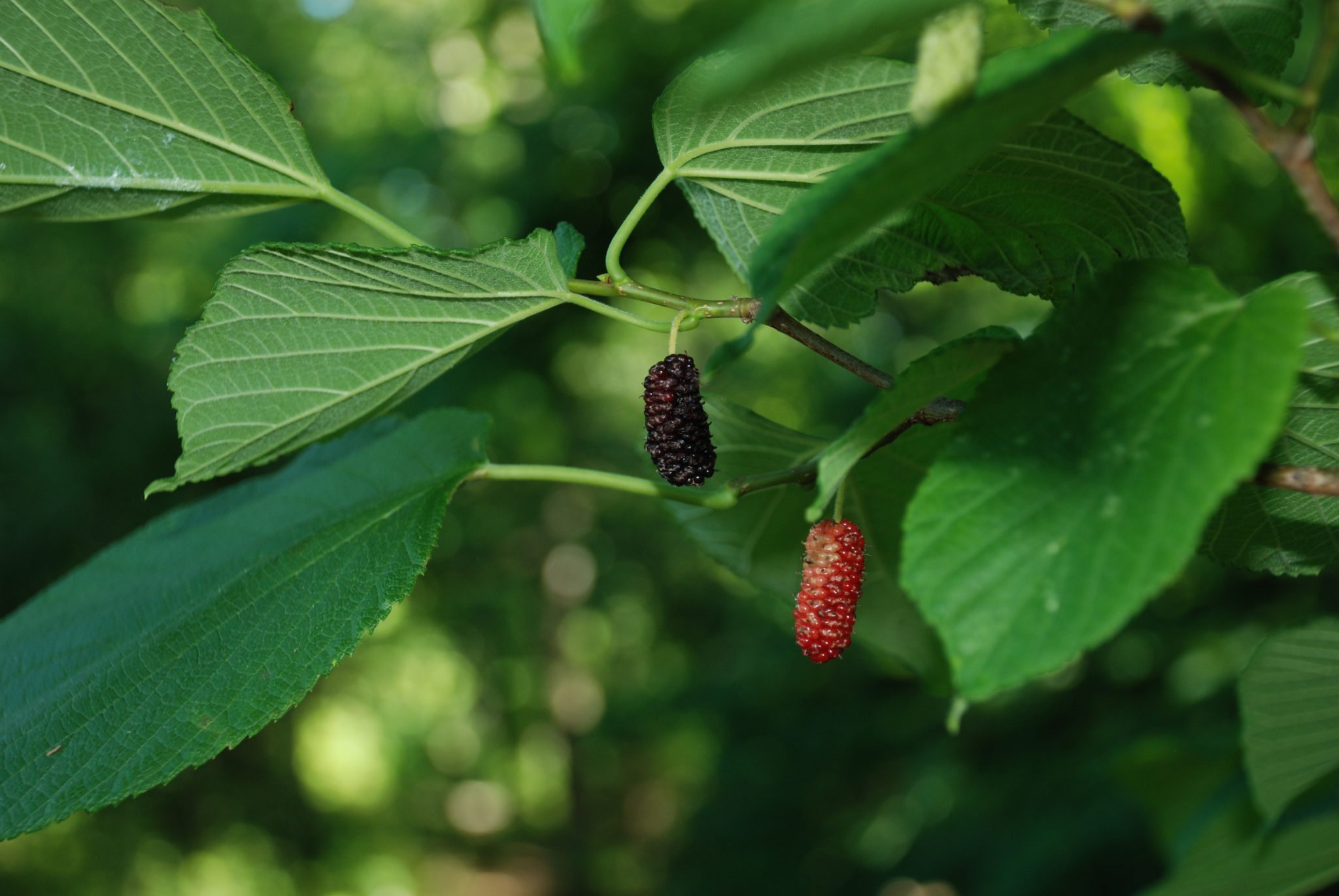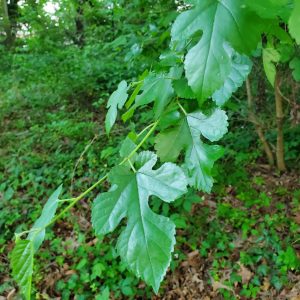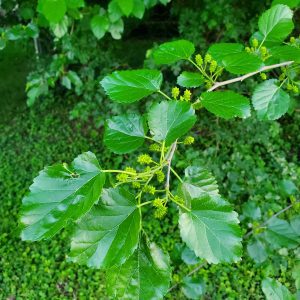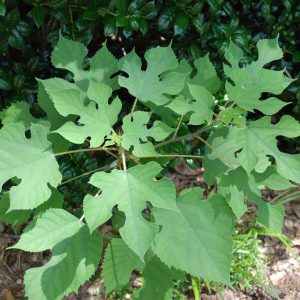Forestry

Description
Red mulberry is a member of the family Moraceae, which also includes figs, and is the only mulberry species native to Alabama. A mid-sized tree up to 60 feet tall—it grows wild across much of the state—thriving in bottomland woods, fencerows, old fields, and vacant lots. Its leaves are large, heart-shaped or variously lobed, and scabrous (rough) on their upper surface. When grown in open areas, trees are comparatively stout with a round crown. The bark is smooth to scaly and thin. Because of this thin bark, red mulberry is very sensitive to fire. The flowers form as small green-yellow catkins, which are followed by an aggregate fruit, similar to a blackberry. Unripe fruit is greenish white, becoming red or a deep purply black at full ripeness in early summer. Because plants are generally dioecious, separate male and female trees are needed for good pollination. Though some monoecious specimens do occur, they are not very common.
Uses for People
Red mulberry is an excellent shade and structural tree due to the large leaves and growth form. Its fruit is delicious, with a rich sweet flavor, best enjoyed picked fresh from the tree. Unfortunately, the fruit is very fragile and does not keep well. When abundant, it is best made into juices or wine, preserves or jam, and is excellent baked into pies. Trees yield moderately well but the harvesting window is generally only a few weeks. A pleasant tea can be made from the young leaves.
Preparations
Freezing is a good method for preserving red mulberry fruit. When freezing select ripened fruit, which is almost black in color, gently rinse the berries under cool, running water. Next, allow berries to air dry and arrange in a single layer on a baking sheet. Place in freezer and allow to freeze for at least 3 hours. Transfer to freezer bag, and label with contents and packing date. Freeze for up to 6 months for best quality.
When preparing jams or preserves, using tested recipes from USDA or any Extension organization will ensure a safe product.
Mulberry fruit is a great addition to a refreshing summer drink. They add a sweet and tart flavor to tea or flavored water. Substitute fresh or frozen mulberries in place of the berries in the Live Well Alabama water infused recipes. Mulberries are packed with vitamins. According to Untied States Department of Agriculture (USDA) nutrition information for raw mulberries, a serving size of 1 cup will give you 36 milligrams of vitamin C, 194 milligrams of potassium, and 39 milligrams of calcium.
Uses for Wildlife
Many species of birds and mammals enjoy the berries as an early summer food source. Numerous insects consume the foliage, and deer and other herbivorous mammals will eat the young foliage and bark from younger trees. Trees provide a good source of shade and locations for nesting.
- White Mulberry (Morus alba)
- White Mulberry (Morus alba)
- Paper Mulberry (Broussonetia papyrifera)
Cultivation
Red mulberry trees are often available online or from native plant nurseries. The trees can also be grown easily from seed, or from cuttings (which are easy to collect during winter pruning). Because the trees are often dioecious, it is best to plant several to ensure good pollination and fruit production. Red mulberry should have few issues with disease or pests when grown in Alabama from good stock and on an appropriate site. That said, it is possible to improve the health and yield of your mulberries with a little effort.
Mulberry trees grow quickly and will often grow too tall for easy hand harvesting. For better access and to maintain a good growth form, it is best to prune the tree to a shorter height. Prune in late winter and follow Extension pruning guides for best practices. Trees may bleed a milky sap-like figs when pruned, but this is reduced if pruned at the appropriate time. Pruning branches greater than two inches in diameter should be avoided due to risks of excessive bleeding, slow healing, and vulnerability to disease. Though they can grow well in shaded areas, better yields will be realized with good sunlight. Occasional deep watering during periods of severe drought can benefit production, particularly if planted in a more upland area. Likewise, while they can grow on many soil types, occasional fertilization in the early spring can keep them healthy and vigorous. It is best practice to test your soil before fertilizing to ensure an appropriate nutrient balance. Light compost and mulching around the roots (but not directly at the base of the tree) will benefit soil quality and reduce weed competition.
Whether encouraging plants found on your property or buying from a nursery or seed supplier, ensure you are planting native red mulberry. Introduced white mulberry (Morus alba) is very closely related to our native species and readily hybridizes with it, diluting the native stock. Its berries are also markedly inferior in flavor. Paper mulberry (Broussonetia papyrifera) may also be mistaken for native mulberry when young, but its leaves and growth form are more distinct and the fruit, though edible, does not resemble either red or white mulberry. White mulberry may be distinguished from red mulberry by its glossy (glabrous) leaves, whereas paper mulberry is strongly pubescent (fuzzy) on both leaves and stems. Furthermore, both of the non-native species can be invasive.




